ARTICLE AD BOX
 Image source, PA Media
Image source, PA Media
By Katy Austin
Transport correspondent
Newly released details reveal how part of the UK's air traffic control system shut itself down after receiving highly unusual duplicate markers on a flight plan.
Hundreds of flights were delayed or cancelled as a result on 28 August, a Bank Holiday, and the day after.
Air traffic services provider NATS said it had never happened before.
It said it had taken measures to prevent the situation from happening again.
The UK's aviation regulator, the Civil Aviation Authority (CAA), announced an independent review, expected to report in a few months' time. The CAA said it could take action if NATS had breached "statutory and licensing obligations".
In its initial report published on Wednesday, NATS said that at 08:32 on 28 August, its system received details of a flight which was due to cross UK airspace later that day.
Airlines submit every flight path to the national control centre; these should automatically be shared with NATS controllers, who oversee UK airspace.
The system detected that two markers along the planned route had the same name - even though they were in different places. As a result, it could not understand the UK portion of the flight plan.
This triggered the system to automatically stop working for safety reasons, so that no incorrect information was passed to NATS' air traffic controllers. The backup system then did the same thing.
This unfolded in just 20 seconds.
Engineers struggled to fix the problem, and called in the manufacturer for help.
Martin Rolfe, managing director of NATS said it was the first time this had happened in the five years the software had been operating, having processed more than 15 million flight plans.
Mr Rolfe said the system did "what it was designed to do, i.e. fail safely when it receives data that it can't process". He added that "it was a one in 15 million flight plan that we received", meaning the engineers took a few hours to work out a situation they were not familiar with.
With planes and crew out of position and most flights already booked up, many people found themselves stuck abroad on what is usually a big day for travel - a Bank Holiday - facing long waits to get home.
As last week went on, airlines put on extra flights in an attempt to clear the backlog.
But questions have remained over how one flight plan could cause such huge disruption.
For a period during the disruption, flight plans had to be processed manually, which meant restrictions were imposed on the number which could be handled.
At one point, only 60 could be handled per hour, down from the usual 400.
The system was back online just before 2.30pm. It wasn't until just after 6pm that restrictions on air traffic were fully removed.
NATS says a software update will mean its system will no longer react in the way it did, if the same thing were to happen again.
Both NATS and the CAA say safety was never compromised.
The NATS report also cites Eurocontrol data as showing 5,592 flights operated in UK airspace on 28 August, 2,000 (or 25%) fewer than had been expected. This includes cancelled flights and those which avoided UK airspace.
NATS believes there were around 1,500 cancellations on the Monday alone.
All airlines operating in the UK were affected.
Even though the outage lasted less than four hours, the knock-on effect lasted for days.
"Systems of this nature are used throughout the world and this scenario has never been encountered before," wrote the CAA after its assessment of NATS's report detailing what went wrong.
The CAA said the event "is now understood and should it reoccur would be fixed quickly with no effect to the aviation system".

 1 year ago
32
1 year ago
32








 English (US)
English (US)